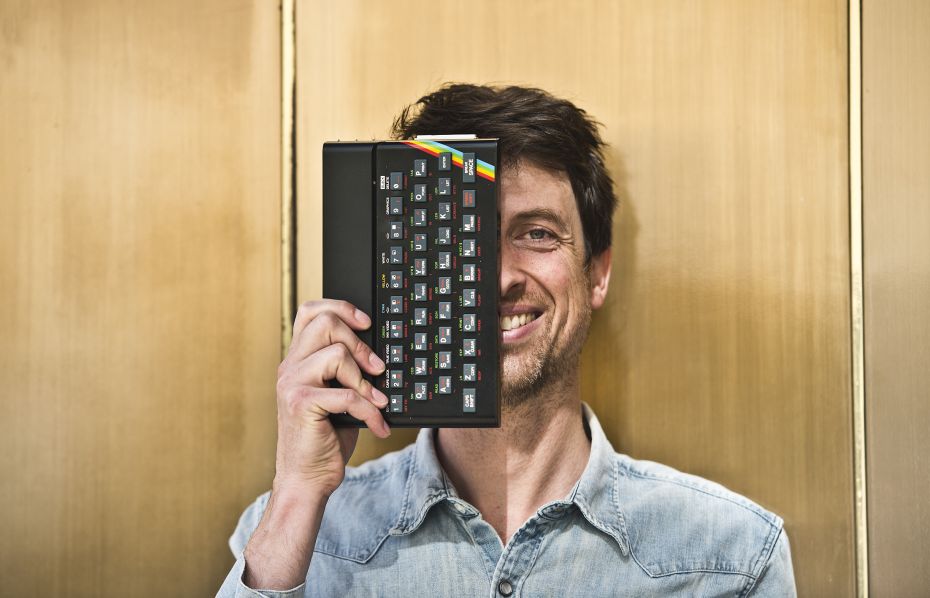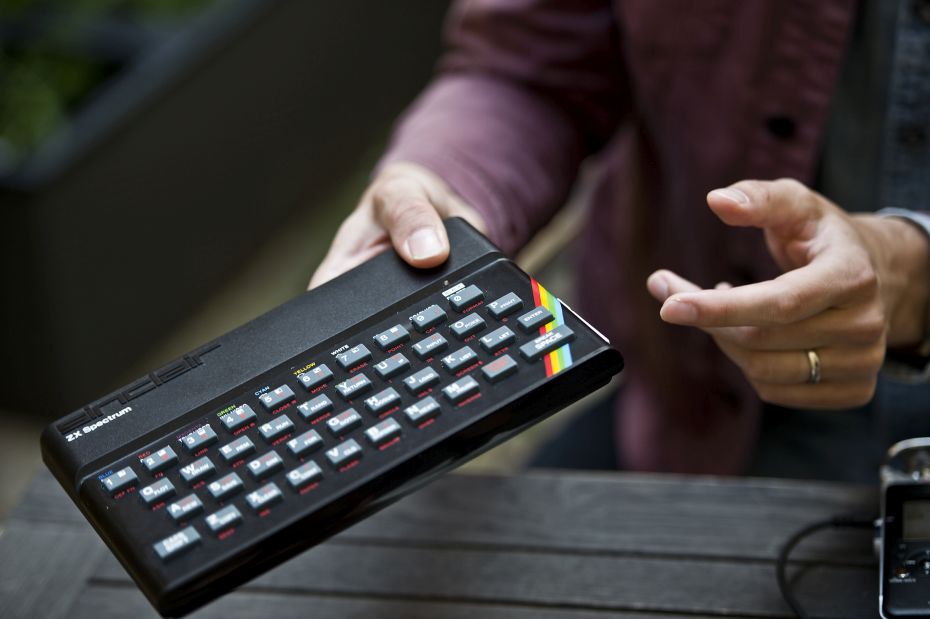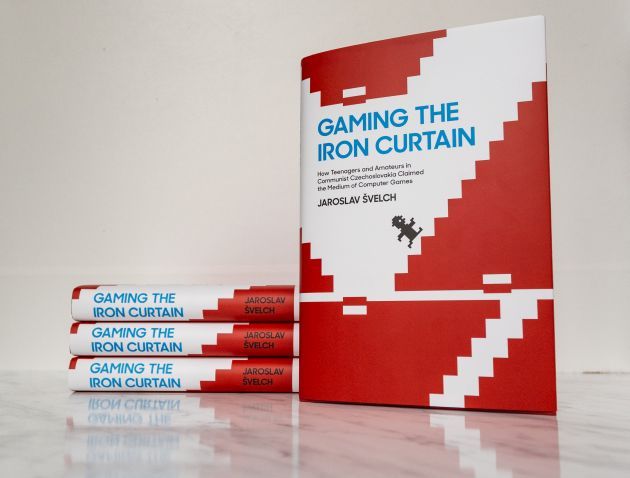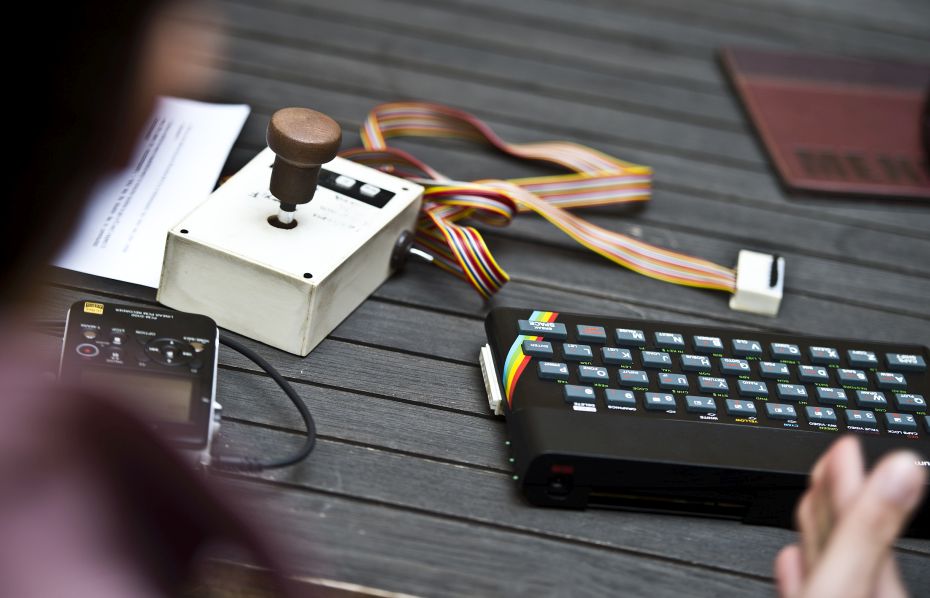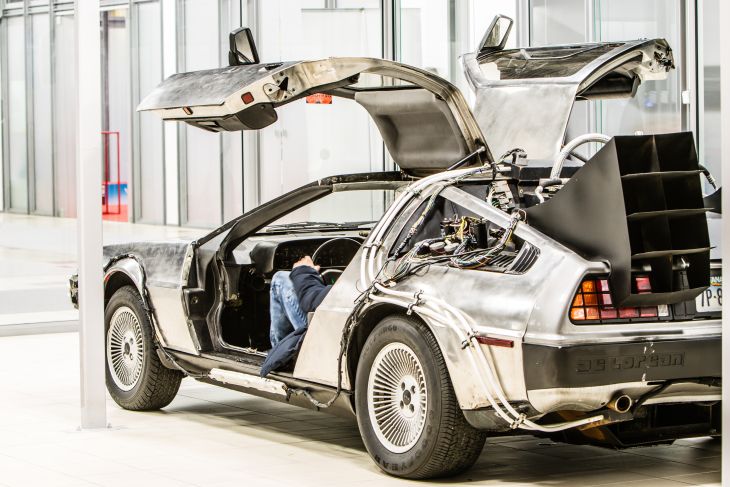PCs were almost impossible to get in 1980s Czechoslovakia but microcomputers proved a different matter. As so-called micros were smuggled into the country and hobby programming quickly caught on, enthusiasts soon coded all manner of computer games. Under the radar of the authorities, some subtly - and others rather daringly – mocked the communist regime and Soviet symbols of power. Jaroslav Švelch, an assistant professor of media studies at the Faculty of Social Sciences at Charles University, wrote a successful book about it called Gaming the Iron Curtain, published by MIT Press.
When we met at the Carolinum, he told me not only about his findings but about how his own foray into computers as a child in the 1980s, began.
“The first time I saw a microcomputer was as a kid at my dad’s work in the 1980s. He worked as a programmer for Solo Sušice, a famous factory that used to produce matches and other wood products, and they had machines there including an East German computer called the Robotron.
“It was an 8-bit machine that had this black & green screen and you could play a number of basic games on it that were text only but still fascinating and thrilling. Equally thrilling was the fact that you could do your own programming on it. It was clear that there was just so much you could do.”
How common were microcomputers in Czechoslovakia? And, in general, where do microcomputers fit in?
“They were the most viable option and the most common in communist Czechoslovakia if anyone had a computer at all. For a reason. Excluding big institutional mainframe machines, the first PCs - personal computers - were for business use (like IBMs) but they were very, very expensive even in the West and you couldn’t get them here. You could program on them, they had text editors, word processing, spreadsheets, but they were just very costly.
“By contrast, microcomputers or micros were cheaper versions of the same thing and they were very compact and could be smuggled into the country. They weren’t very open in terms of the hardware architecture – they were more of a consumer product – it wasn’t that easy to take one part out and replace it with something else, or to modify it or to upgrade. But you could program on them.
“The third category was video game consoles which lacked a keyboard and usually you couldn’t program your own code and your own games. And these used cartridges instead of floppies or tapes.”
Microcomputers could be hooked up to a TV screen?
“Most of the time, yes. That was one reason they were also so popular. They were very versatile, very compact, you didn’t need much additional hardware beyond the computer. You could take the Sinclair ZX Spectrum, a British 8-bit microcomputer, and hook it up to your TV or to a tape recorder and didn’t need a lot of specialised hardware to use it.”
You mentioned cassettes – today it’s easy to forget they were used to store games…
“That’s right: cassettes were the No. 1 data storage medium in the Soviet bloc for most of the ‘80s. In the West, they began being replaced by 1984 by floppy discs which were much more expensive but which certainly ran faster. But in the Soviet sphere and in Czechoslovakia people were used cassettes almost until the 1990s.”
There was a lag in avalable hardware – if you got your hands on a computer at all?
“Yes, in a manner of speaking. Computers weren’t officially imported or only on a very limited scale. People tried to get their hands on them from abroad but that was extremely hard. People had to smuggle them in. bringing them in legally was not practical as the customs fee were just incredibly high.
“To do so, people had to spend a lot of money to be able to get their hands on western currency, then maybe to bribe someone to get a permit to travel to the West. While there, they bought the computer and then officially had to pay customs fees that almost matched the price of the computer! A lot of people opted to just smuggle them in, instead.
“The Spectrum was particularly suitable because it was so compact and easy to disguise. One thing that I heard that people did (although it is hard to verify) was to buy a box of chocolates and hide the computer inside. It fit easily, as you can see. Or they would wrap it in sandwich paper and would basically disguise it as food. And presumably it worked. The ZX Spectrum was much smaller than similar machines like the Atari microcomputers or Commodore 64: the size was ideal.”
Even though it was hard for people to get their hands on hardware or software… young people, enthusiasts and budding programmers, must have been excited by what was going on…
“It was an interesting situation. On the one hand, you had the authorities and a Party line that was very much promoting technology. The scientific-technological revolution was kind of official policy and the government and the Communist Party were aware that computers were the future and that they had to do something in that regard. Programming and general technical skills were very much supported and even in magazines and newspapers then you could read about how computers would play an important role even in the future of the socialist economy.
“At the same time, it was very hard to get the machines and Czechoslovakia’s centrally-planned economy was simply unable to produce anything like them, they were hard to import. So they were the future but they were almost nowhere to be found and nowhere to be bought.”
Czechs who got their hands on microcomputers became most active in games programing?
“They did all kinds of things. They programmed games, they made homemade versions of some peripheral items, such as joysticks, and they were even able to modify some hardware. It wasn’t trivial: you had to do some soldering. Even if we look at the Spectrum I have with me today, you can see that it has a custom port and there was some soldering inside. Then there are some buttons here that weren’t on the original so it has been modified – it was possible.
“People also had to do their own repairs because obviously they had no access to anything like official servicing. When the keyboard broke, which happened quite often with the Spectrum, they needed to replace the keys – they would have to fix it themselves or build an external keyboard. That was hardware, and in terms of software they did all kinds of things: games or productivity software.”
What games from the West were popular? Or copied?
“It always depended on the platform and in Czechoslovakia the most popular computer was the Sinclair ZX Spectrum we have been talking about. This was a British machine which was only successful on some markets in the world: it had a big market share in the UK and in Spain, so the games that made it here were usually either British or Spanish. At the same time, the British games were often ports or clones or conversions of American or Japanese games. So the trends have been filtered through several intermediaries before they came to Czechoslovakia. One example of a very popular game was Manic Miner from 1983. The main character was a miner you guided through a series of caverns to look for treasure.
“It was funny and a little surrealist and immensely popular in Czechoslovakia. People did a lot of conversions to other platforms, some even domestically produced such as the Tesla PMD 85. There weren’t that many of these machines, some were at schools, and some people did conversions of the game for that and other platforms.
“People did all kinds of clones of Manic Miner: games which were very similar but featured different characters or different levels. Up until 1985, people were still modifying and creating new versions of it.”
Many people outside the Soviet bloc or sphere of influence had little idea of what life was like behind the Iron Curtain – there is no question the regime was oppressive but at the same time is it possible to say people in the 1980s breathed a little easier? Or to put it another way, was the ground ripe for this kind of creativity in computing?
“I would say so. Hobby computing and similar hobbies in fact became popular because of oppression: the thing is, unless you were a member of Czechoslovakia’s Communist Party you didn’t really have substantial career opportunities. You were basically stuck in one place. The way you could find self-fulfilment was either in private life (having a cottage or a garden) or by taking part in hobby groups. Hobby groups were extremely popular and to an extent they were supported by the state as a kind of continuing education they could sometimes then apply at work. But it didn’t always work out that way.
“People had a lot of free time and they didn’t have that many options. And many of these activities, surprisingly, weren’t really regulated and there was no ideological content. People would just work on projects of their own design and there wasn’t much oversight.”
Czechoslovaks – under an ineffective planned economy – often suffered shortages of some items or long waiting periods or simply couldn’t get needed equipment. Were they were used to looking for D-Y-I solutions?
“It was definitely the spirit of the times. People who became involved with computers, for example, were the same who before had been members of electronics clubs, where they were soldering radios and so on. So yes, many people were used to fixing things on their own.”
Your book is called Gaming the Iron Curtain – in what way did programmers here do that in the 1980s and what was the result?
“Many of them were mocking the regime: it started with games that made fun of Soviet iconography and Soviet mythology. There were games like Shatokhin about a major in the Red Army whose mission it is to kill John Rambo. So you had this kind of pastiche, this kind of mashup of the Rambo movies and the Soviet propaganda film Solo Journey (also called The Detached Mission) featuring Major Shatokhin.
“In the process, the main character gets humiliated and killed a lot: he falls out of a helicopter, gets burned to a crisp and all of it was kind of graphically described. So on the one hand the Soviet soldier is the ‘hero’ but he is constantly humiliated by Rambo. And I think this was a very smart way of writing the game and it was very funny.”
This was a text-based game?
“Yes, it was a text adventure. About 50 percent of the games that were made for the Spectrum were text adventures. For many reasons: one was that it was simply easier to program. Graphics and animation were hard to code and to draw. In text adventures, you could actually tell a story much more powerfully than in the action games of that era. The only graphics were a loading screen with the face of the major and the hammer & sickle, for example and then you started playing. So there were games like that which were cleverly subversive.
“Another subversive game from that era featured Indiana Jones on Prague’s Wenceslas Square: he gets beaten up shortly after Palach Week in 1989 which was brutally supressed by the secret police. He was a very popular character in text adventures here. In this game he happened to be on the city square when there was a demonstration and he gets beaten up by the police and he has to fight back and defeat various members of the communist police and people’s militia and get to the subway and escape to the airport.
“It’s a very violent game and I think it was a bit of a revenge fantasy. It was written anonymously – we still don’t know who the author was – but I imagine it must have been someone who experienced it or someone who was disturbed by what happened. This game allowed you to fight back and to get revenge on the authorities.”
In terms of the methodology, you interviewed around 40 people for the book: how do they look back on that era?
“Most were pleasantly surprised that someone was interested. It was more than 30 years ago and many people simply moved on. The memory has faded a bit. Some became quite famous and maybe around one-fifth of them are still active in retro-gaming circles. Others simply made some games in the 80s and forgot about them. But they were pleased that the period was being researched.”
We have been talking about microcomputers and programming but neglected to talk about arcade games. I know that these trickled into Czechoslovakia as well in the 1980s.
“It was hard to import them, you would have to pay customs fees, and at some point the people bringing in these games figured out that you didn’t have to bring in the whole machine but only had to smuggle in the main board and to build the rest locally. One of them, Tomáš Smutný, is well-known and has openly discussed the period. He and others would build these arcade cabinets with carpenters and for the monitors they used Soviet-built TVs that were smuggled in. They would even build their own joysticks. Everything but the board was made locally. It was much cheaper than trying to bring in the whole cabinet from the West.”
And everybody got paid…
“It was money in the pocket but it was not without risks, either. Smutný was actually arrested by the authorities for unauthorised enterprise which was illegal.”
What was the outcome?
“The case never went to trial but was dropped and there was expert testimony which was favourable to him – that what he was doing was repairs, not manufacturing. It’s an interesting conceptual question, actually, but the expert said it was only repairs and so Smutný was released and was able to spend Christmas with his family.”
One follow-up: did they paint the arcade game cabinets to look at all like the originals?
“Usually they didn’t. It was very bare bones. Wood planks that weren’t embellished.”
I know of one museum/arcade outside Prague where they have a lot of the first or second generation arcade games – Pac Man II, the Gauntlet - so in a way the dream lives on.
“That’s true. There is one at Červený újezd outside Prague that is pretty good. But it has to be said that collectors brought in a lot of these games later; these were not the games that were around in the 1980s.”
Most of those were lost?
“Most of them were lost. Arcade games had long became obsolete and for a time they were stored at Prague’s Výstaviště fairgrounds. But the grounds were hit by major floods in 2002 and were destroyed. This was before the rise of retro interest in those games.”
Speaking of retro, we are kind of in a situation where film and popular books are looking back at the 80s with a certain amount of nostalgia, whether it is Bumblebee (The Transformers), Ernest Cline’s Ready Player One, or the phenomenally successful Stranger Things… Have you registered that wave?
“I think it may help sell a few copies of the book (laughs). You know, I was born in the 1980s so my own memories are hazy but it is important to say that as a researcher and author I avoided anything like nostalgia in the book – the point is to be as impartial and objective as possible.
“It’s great that many people are interested in the period but historians have to be aware of the pitfalls. Especially in cultures that were more peripheral than the US, people start to adopt memories of the past that weren’t really theirs.
“So young people here might watch Stranger Things today and think that is what the 80s were like… even here! I mean, it is not even accurate of the 1980s in the US – but it is doubly inaccurate for Czechoslovakia. It is certainly the mission of historians to popularise their subject but you also have to point out very real differences and to debunk some of the myths.”
| Assistant Professor Jaroslav Švelch |
| Jaroslav Švelch was born in Sušice, Czechoslovakia in 1981, and graduated in media studies and linguistics from Charles University. In 2007-2008, he was a visiting PhD student at MIT. He is now an assistant professor of media studies at the Faculty of Social Sciences, Charles University. His latest work is the recent monograph Gaming the Iron Curtain: How Teenagers and Amateurs in Communist Czechoslovakia Claimed the Medium of Computer Games (MIT Press, 2018), in which he traces the hidden histories of home computing and gaming in the former Soviet bloc. In 2017-2019, he was a postdoctoral fellow at the University of Bergen, Norway, working on a project about the history, theory, and reception of monsters in games – which will be the topic of his next book. He is a co-founder of the Central and Eastern European Game Studies conference, an annual gathering of game scholars from the region. |


